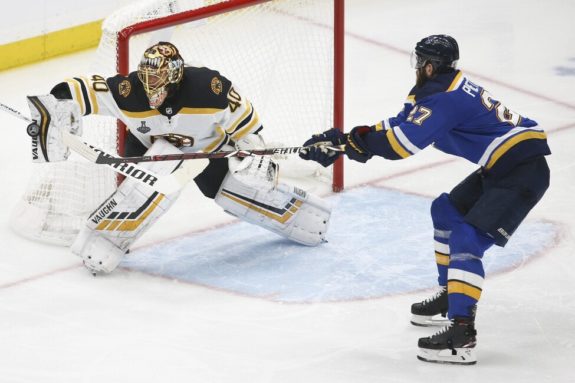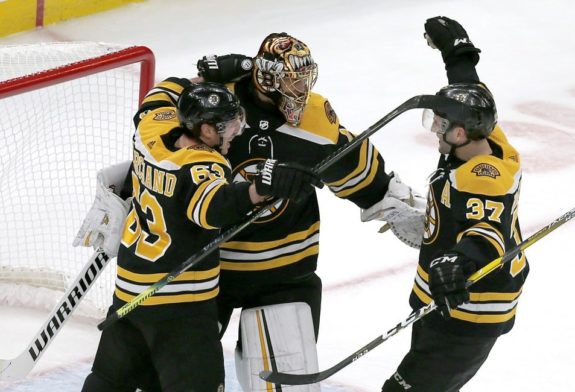Tuukka Rask is a very good NHL goaltender.
Sound the alarms. The most polarizing figure in all of Boston sports is being praised for his performance throughout the 2019-20 regular season.
For some, this praise is well-deserved given how unbelievably well Rask has played through his first 14 starts of the season. Allowing only 29 goals in those 14 contests, good for a 2.05 goals-against average and recording a .931 save percentage and a 9.87 GSAA (goals saved above average), Rask has proven that he’s among the NHL’s best.

For others, the same storylines have been beaten to death for years and there’s simply no reasoning with them as to why or how Rask can be considered a good goalie.
Rask has debunked much of the logic time and time again but there will always be those who prefer cherrypicking all of the bad and discounting all of the good. Engaging in discourse about the topic has become asinine because many fail to acknowledge both sides of the coin.
Rask’s Good is Seemingly Outweighed by the Bad
Nobody is saying that Rask has been the perfect NHL goalie. Nobody is arguing that he didn’t have a stretch of mediocre-to-okay seasons behind shaky-defenses, failing to justify his $7 million annual cap hit.
More importantly, nobody is saying that Rask doesn’t have bad games, miss easy saves from time to time or have baggage, the same as every other goalie in the NHL.
Regardless of this, every positive Rask remark will forever be met with a cry from people who criticize Rask for his worst moments, such as Game 6 of the 2013 Stanley Cup Final that saw him allow two goals in just 17 seconds or Game 7 of the 2019 Stanley Cup Final that saw him allow two goals on four shots.
What those people won’t bring up is the fact that Rask allowed just 46 goals in 22 games in 2013, making 715 saves on 761 shots (good for a .940 save percentage) as well as a 12.76 GSAA.

They’ll also neglect to mention that Rask was the Bruins best player throughout the 2019 Cup run and, had the Bruins won, he’d have undoubtedly been awarded the Conn Smythe Trophy for being the MVP of the postseason.
This was due to him allowing just 49 goals in 24 games, stopping 693 out of 742 shots (good for a .934 save percentage) and a 13.04 GSAA.
More importantly, there were many other players who deserved to shoulder a fair share the blame for that Game 7 loss rather than Rask. While many of those players, including Brad Marchand and David Pastrnak, have been forgiven due to their incredible starts to the 2019-20 campaign, Rask will always be the easy target for those who just want to watch the world burn.
The Quality of Rask’s Saves are Noteworthy
Rask isn’t just making easy saves this season either as he’s head and shoulders above his peers in high-danger save percentage this season.
Stopping 87 out of 95 high-danger shots-against this season according to Natural Stat Trick, Rask has posted a .916 HDSV%. to put that in perspective, the next-highest save percentage on the list comes from Jordan Binnington who has recorded a .894 HDSV% (though he’s done so in 160 shots-against which shouldn’t be diminished).
He’s being overshadowed by the performances of both Marchand and Pastrnak due to how incredibly well they’ve played all season long, but there should be no mistake made about it; Rask has been one of the most important players for the Bruins this season.
He exemplified this by making a save-of-the-year candidate against the Buffalo Sabres, stopping the would-be tying goal with his blocker hand in improbable fashion.
Rask would also keep the Bruins afloat early in that contest, making 17 saves in the first period while his team would take only four shots on net in the opening frame.
Related: Marchand, Pastrnak Lead Bruins Past Sabres 3-2
If people want to see Rask steal a game (excluding the most recent postseason which doesn’t seem to count for one reason or another), they got a good glimpse of it against the Sabres.
His efforts didn’t go unnoticed by his teammates, either.
There are going to be bumps in the road and Rask won’t always be playing at his best. This is normal for every athlete in every sport throughout history. With that in mind, though, it would be foolish to only mention those poor stretches without balancing it and acknowledging the good ones, too.